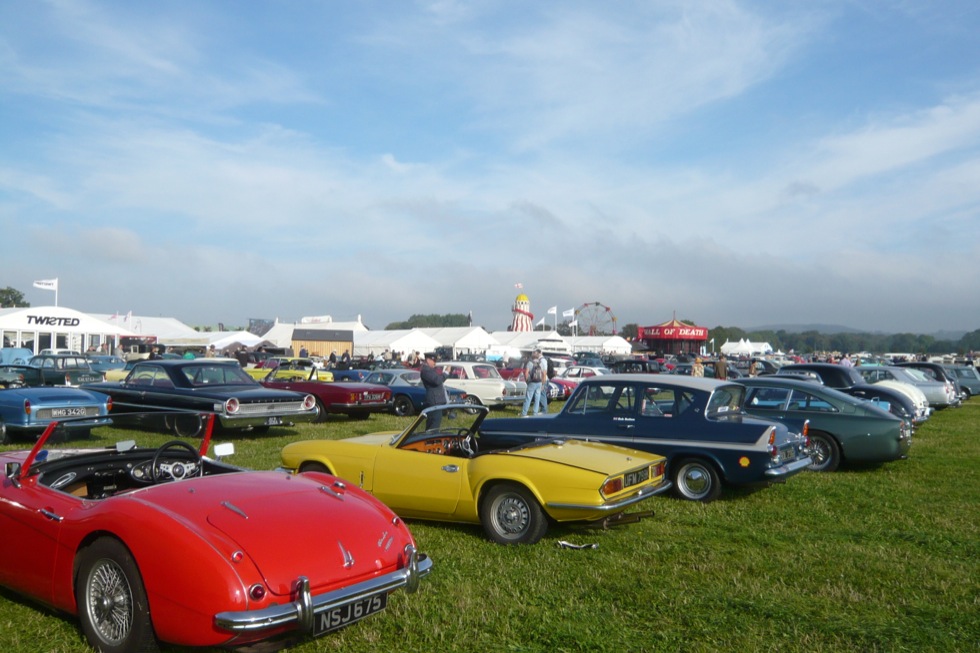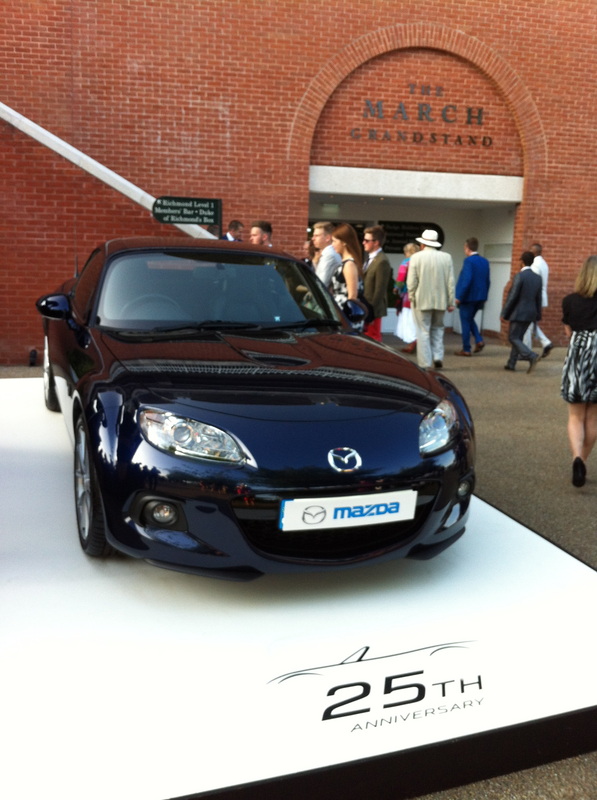| We almost didn't go to the Goodwood Revival this year. It's so big, it's so expensive, and all the best bits are fenced off for the corporate guests. Part of the feeling of peevishness is down to that feeling you have when you loved a band when they were small, and you used to see them up close in tiny venues, but now you have to shell out for a stadium and share them with the rest of the world. We loved the Revival when it was smaller, quieter and charming. Now it's huge, and everyone else is there. But we went for a day and ended up wishing we'd gone for the weekend. There's so much to see, gorgeous cars racing their wheels off, classic planes roaring overhead, beautiful people, bikes, clothes etc. We enjoyed catching up with lots of friends, including Sarah and Jake from the Planet Sputnik Gang and Sue and Dave from Hotrod Tiki, watched some excellent racing and got to wipe away a tear as two Lancasters rumbled out of the twilight. No doubt we'll be back next year. See my gallery of photos here |
|
0 Comments
 Once again sculptor Gerry Judah created an elegant and striking centre piece for the Goodwood Festival of Speed, this year with Mercedes as the featured marque. Here's my interview with the charming and thoughtful Mr Judah for the Goodwood social media site FortyOneSix in 2012. Priceless cars dangle from wires, are skewered on spikes or hover in the fronds of a giant feather; an enormous E-type constructed of giant pipes sits perpendicular to the ground. The sculptures creating a focal point outside Goodwood House at the Festival of Speed each year are conjured up by artist Gerry Judah. He says they have three criteria: they must be completely different, they must be as huge as possible and they must look dangerous. After all, motorsport is a dangerous pursuit. Judah’s art draws on his rich cultural heritage. His grandparents were of Jewish Baghdadi descent; he was born in Calcutta in 1951, and grew up in West Bengal before his family moved to London when he was 10. The scale and grandeur of Indian subcontinent’s temples, synagogues and mosques can often be seen in his work. He has created spectacular settings for the BBC, Ridley Scott Associates, David Bailey and musical giants such as Paul McCartney, Michael Jackson, Led Zeppelin. He’s created made powerful installations for Amnesty International. For the Imperial War Museum’s Holocaust Exhibition, he created an understated, and deeply moving, diorama of the selection ramp in Auschwitz Birkenau. He says “My other work is about moments of history: war, the environment, politics, but all my work is emotional. You can’t get more emotional than massive loops of steel with cars on them. And again, it’s something far beyond you, you can’t understand why someone would destroy a race of people; maybe you can’t understand what drives someone to race a car at such speeds and risk their lives.” Judah knew talented still-life photographer Charles Settrington long before he became Lord March, and now the two work closely together. He says “He is my focal point. He has a terrific eye for sculpture. At Goodwood he gives people what they are looking for, but surprises them. That’s what the sculpture should do.” Each year Gerry is given the marque to be celebrated, particular cars or occasionally a story, such as the GT40s’ Le Mans victory, after that he says the sponsors leave it to his soaring imagination. He says “The first and hardest thing I have to do is to make something with no connection to anything I’ve done before. I must become a different person each year, think differently, each company is different, but I’m not about brands, I’m looking for the spirit of the company.” As he mulls it over, he says “Ideas can come to me while watching the television or eating breakfast, and when it comes, it comes in a flash.” Then he gets sketching and his studio fills up with little maquettes in card, plastic and metal. He emails the ideas to Lord March and to Bruno Postle at structural engineering firm Capita, frequently sending and receiving from his Blackberry while he’s out and about. He quotes Gene Kelly, who once observed “genius is making something difficult look easy”. For everyone who has stood in front of one of Judah’s vast structures wondering how on earth it stays up – the answer is to do with finding the centre of gravity, and some serious engineering know-how. Gerry says that although he needs to understand the principles, he is not an engineer. He is full of praise for Bruno for his engineering advice and for the fabricators at Littlehampton Welding, saying they are ‘the heroes’. Every structure is a monocoque, that is they have no internal frames, the sections of metal become stiff and strong as they come together. The immense Jag is a good example. The brief was simply to celebrate the E-type, a car that’s more famous for its beauty than motorsport success. He says “I wanted to encapsulate the shape of the car as a motif. I decided to treat it like a building and make it as huge as possible.” From here form followed function, steel tubes are very strong and light, so he put them together like columns and cut out the shape of the car. The Jag is to be resurrected outside the factory, but it’s unusual. Each Festival of Speed weekend is an ephemeral event that stays in memories and photos, and most of these wonderful pieces of art, end up recycled as cutlery and china. The structure of year’s centerpiece for Lotus will also have a home at Hethel, but without its mobile stars. As part of keeping things a surprise, no images of the sculptures are released before the Festival of Speed. When we speak before the event, however, Judah is brimming with excitement about his installation for Lotus. Before Christmas, he learned that the starting point for 2012 was a collection of Lotus race-winners. With such great cars, he says “There’s no need to embellish, you need to get to the purest form”. (Much like Colin Chapman’s engineering.) He says “It will be quite extraordinary, a twisting road in the air with cars zooming about on it.” 1997 Ferrari This was the first major central display at the Festival of Speed. Gerry Judah says “Charles March remembered me from the days when I built theatre sets, and asked me to make the triumphal arch.” In this simple installation, a Ferrari F310B was suspended nose-down from a Roman arch. A couple of banners completed the display 1998 Porsche The first real FoS ‘sculpture’ celebrated 50 years of Porsche. Five iconic race cars were displayed like lollipops on long poles. They were a 1971 Porsche 917 Long Tail in Martini colours, the 1971 Porsche 917/20 ‘Pink Pig’, Jacky Ickx and Derek Bell’s Le Mans-winning 1981 Jules Porsche 936/81, a 1986 Porsche 962 Rothmans IMSA racer and a 1997 Porsche 911 GT1 car. 1999 Audi The four rings on an Audi’s nose represent four car companies: Horch, DKW, Wanderer and Audi. These came together in 1932 to form the ‘Auto Union’, a brand that survived until the 1960s, when the name was changed to Audi. In 1999, the Audi name was 90, Horch was 100, and it was 50 years since Auto Union had relocated to Ingolstadt after its pre-war operations were stranded in East Germany. Slim steel poles represented the famous Avus race track banking, and looked much like a wall of death, with a replica of the Auto Union Streamliner and an Audi Avus quattro concept car clinging on. Three Auto Unions were parked more safely on the ground. 2000 Jaguar Racy big cats were suspended upside-down in a steel ‘cat’s cradle’ to celebrate Jaguar’s return to F1. Seven famous racing cars, including an original Ecurie Ecosse XK120 and the E-type in which Jackie Stewart drove his first race were joined by an F-type concept, its launch estimated as 2003. In hindsight, the cars and dreams look trapped in a giant spider’s web. 2001 Mercedes Judah’s sculpture is intended to resemble liquid hitting the ground. To celebrate Mercedes’ centenary, Mercedes 300SL Gullwing coupe was positioned high on top of a column, while a stressed fabric skin created a perfect ellipse. This structure won specialists in lightweight tensile structures Architen Landrell of Chepstow an Outstanding Achievement award from the Industrial Fabric Association International. As the sculpture was close to completion, however, a fabricator called to say thunderstorms were heading for Goodwood. Gerry Judah had to send a van with a lightning conductor to race the storm and make sure the rare and valuable Mercedes plus installation didn’t take out the front of Goodwood House. 2002 Renault F1 Renault was celebrating 25 years of Formula One success, and the sculpture had its cars racing around in the fronds of a giant feather. Why? Gerry Judah says he wanted a ‘floating landscape’ for the cars and “The French like quirky things, so I thought I’d make it quirky”. The cars were a Renault RS01, RE40, RE60 and R202, Williams FW14 and a FW18 Benetton B195. 2003 Ford
This powerful sculpture like the face of a leaning cathedral, celebrated the famous victory of three GT40s over the Ferraris at Le Mans in 1966. The originals had battled rain as well as the opposition, so water was pumped from a tank under the ground to spray from the car’s wheels. Throughout the gloriously sunny, hot weekend, spectators were happy to be able to stand under the cooling mist. The actual cars were performing on the track so those in the air were replicas. 2004 Rolls Royce Between the wars, Rolls-Royce provided the power for speed records around the world. In this centenary year of the famous name, Rolls Royce Motor Cars got together with Rolls-Royce Plc to celebrate records on land, sea and air. Sir Malcolm Campbell’s original 300mph Bluebird, the 235.54mph Snider Trophy Supermarine S6B seaplane and a specially commissioned replica of the Bluebird K4 boat, driven by both Malcolm and Donald Campbell, all stood to attention, mounted on wing-shaped structures, outside Goodwood House 2005 Honda The only moving sculpture (so far) had F1 cars mounted on eerily swaying sticks. It was inspired by the Japanese tradition of ‘kinetic sculpture’, that is, art that contains moving parts or depends on motion for its effect. Honda was celebrating 40 years of grand prix success, and had chosen to display six cars: the Honda RA272, RA300, Lotus 99T, Williams FW11, McLaren MP4/4 and BAR 006. Some were replicas because the real cars were running up the hill. 2006 Renault This pavilion of stretched canvas over steel, like a giant Pringle, was designed to channel sound. Visitors were treated to a rendition of God Save the Queen using a laptop and a Renault F1 engine. The cars sheltering underneath were a Renault Type AK 90CV and Renault R26. Gerry Judah loves the shape of the roof, saying: “It’s one of the most beautiful things I’ve ever done”. 2007 Toyota It was Toyota’s turn to celebrate an anniversary or two, 75th anniversary of the company and half a century’s involvement in motorsport. Classic racing machines were strung by wire from a series of Japanese torii-gates, like the clacking balls in a classic executive desk toy. The tallest arch was 35 metres high and had to have red lights to warn low-flying aircraft. The suspended cars were a Toyota TS010, Celica GT-Four, GT-One, TF107 and Lola B2/00. 2008 Land Rover Gerry Judah says: "I wanted to make something that looked like a massive rock, with the contradiction that you could see through it." Hundreds of giant steel tubes slotted together like Meccano to create a structure 34 metres tall and 25 metres wide. It took a month to erect. The sculpture celebrated 60 years of Land Rover, so current Land Rover models (Defender, Discovery, Freelander and Range Rover) finished in brushed stainless steel clambered over its surface. 2009 Audi The simplest and possibly the most striking Goodwood centrepiece appeared 10 years on from the ‘banking’ sculpture of 1999, Audi was celebrating its centenary. This time the Auto Union streamliner and an Audi R8 V10 faced one another at either end of a twist of giant Scalextric track. It looked delicate, but weighed 40-tonnes. 2010 Alfa Romeo Gerry Judah says “There was no better symbol to take inspiration from than Alfa’s famous Cloverleaf badge, which has donned past, present and hopefully future high-performance Alfa Romeos." Inside the steel hoops were a 1925 world championship-winning Alfa P2 grand prix racer and an 8C Competizione supercar. This structure, minus is cars, is the only centre piece to have been retired to the Goodwood Sculpture Park. 2011 Jaguar E-type Gerry Judah says: “The E-type is famous for its shape but too small and delicate to hoist into the air. I thought I would like to express the form of the car itself without any embellishments. Everyone recognises the E-type, the shape speaks for itself. You can’t compete with it, you can’t digress from it." So, its iconic shape was created using half a kilometer of painted steel tubes 1,200mm in diameter, intended for use in gas pipelines. The sculpture took 10 days to install by a firm specialising in bridge building. Once complete, it was 28 metres high and weighed 150 tonnes – the same as 122 E-types. Afterwards, it was taken away intact to be installed outside the Jaguar factory. 2012 Lotus See interview 2013 50 Years of the Porsche 911 See You Tube video 2014 Mercedes press release Mercedes-Benz can trace its motorsport origins back through three centuries, to 1894, when Daimler engines powered the world’s first winners on the rough roads of France. It’s appropriate then, that this year’s sculpture at Goodwood Festival of Speed represents that enormous span through thirteen decades. Soaring 26 metres over Goodwood House, this 160-tonne steel sculpture is 90 metres long and was created by artist Gerry Judah. It was 80 years ago when the legend of the German racing “Silver Arrows” was born. Stripped of their lead-based white paint, the 1934 Mercedes-Benz W25 – like the example installed here - won at its first outing at the notorious Nürburgring Nordschleife, with Manfred von Brauchitsch at the wheel – and since then, the company’s works cars have always been silver. The other Silver Arrow soaring overhead is the MERCEDES AMG PETRONAS Formula One Team’s F1 W04. This car, chassis number 04, was raced in 15 Grands Prix in 2013 by Lewis Hamilton, most notably to five Pole positions; to victory in the Hungarian Grand Prix; and to third place podiums in Malaysia, China and Belgium. |
Woman Driver
This blog is by a woman driver, for everyone to read Archives
December 2019
Categories
All
|














 RSS Feed
RSS Feed
